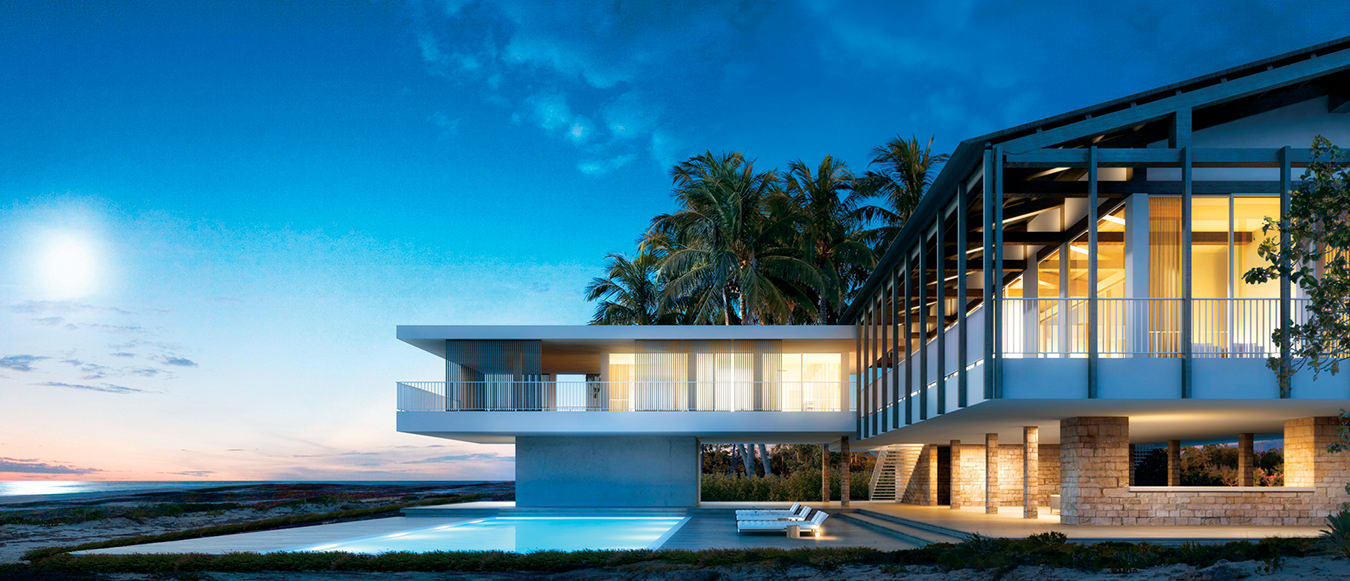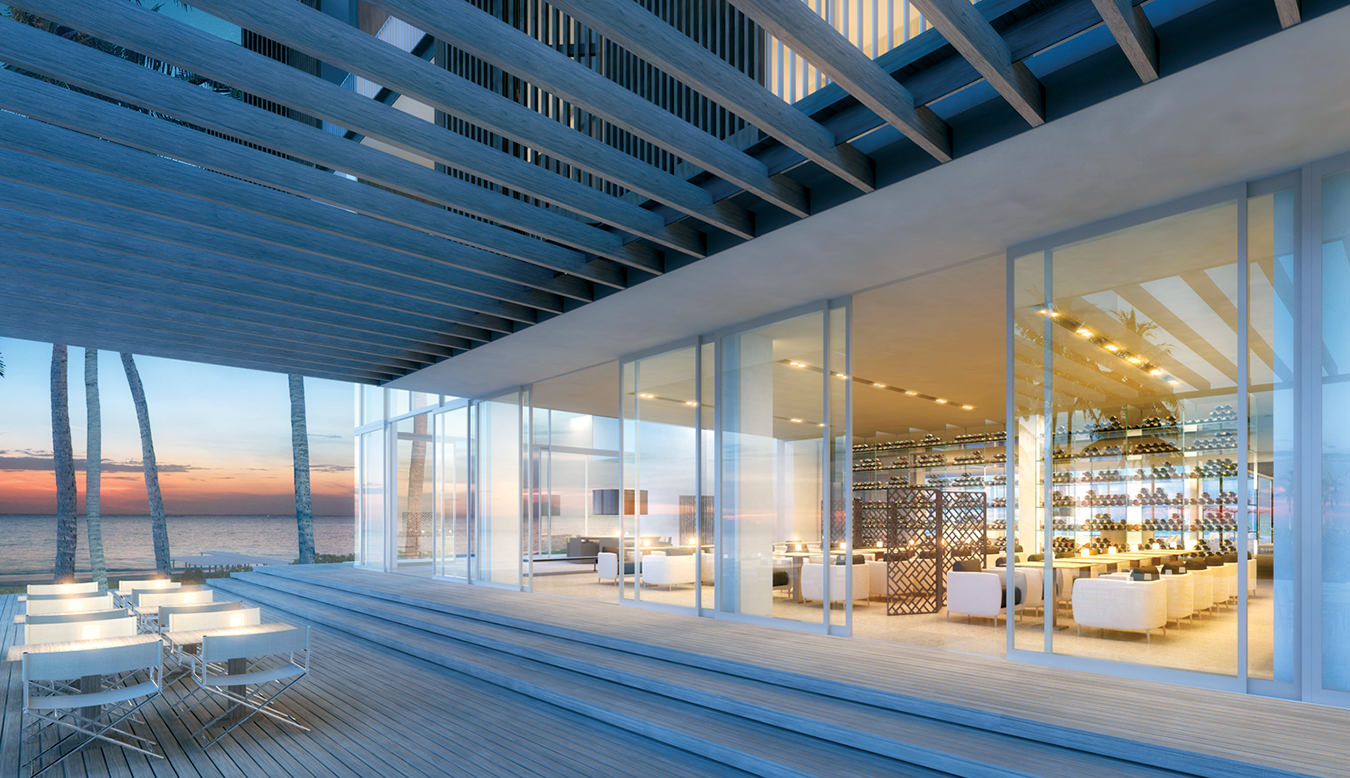-

Dellis Cay, Turks and Caicos Islands.
-

Beach Villa by Piero Lissoni at Mandarin Oriental, Dellis Cay.
-

Mandarin Oriental restaurant, Dellis Cay.
-

Villa by Zaha Hadid.
Island Shopping
An oasis of your own.
Perhaps it was Marlon Brando who popularized the notion of owning an island when he purchased one after filming Mutiny on the Bounty in the 1960s. And in 1963, Aristotle Onassis bought a private island, Skorpios, in the Ionian Sea. And let’s not forget Virgin Group mogul Sir Richard Branson, who acquired Necker Island in the Caribbean in 1979.
Private islands, once available solely to royalty, heads of state and the upper cadre of celebrities, have become an increasingly possible option for those interested in both the real-estate business and the more epicurean desire to secure a perpetually private getaway. Untouched isles are being purchased for much less than you’d think. Property near New Brunswick, for example, can go for about $100,000, and islands near Connecticut or New York start at around $2-million.
The dream of owning a private oasis is, for many, becoming an increasingly plausible opportunity. The benefits of buying an island are myriad: the appeal of escaping to an uninhabited place, the return to nature, the invaluable quiet and seclusion, and the ability to leave one’s demanding and stressful life behind for a relaxing and isolated weekend. High-profile atoll owners like Ted Turner, Michael Douglas and Catherine Zeta-Jones, Johnny Depp, and Brooke Shields have increased exposure and, thus, interest in the private island. And advances in technology, specifically in the fields of solar energy, wireless communications, wind generators, and water and sewage systems, have had a significant impact on making them more easily habitable.
One man taking the island-owning idea to the next level is Dr. Cem Kinay, who recently purchased Dellis Cay, a 560-acre island in the Turks and Caicos Islands. It’s his dream to build a high-end hotel, as well as residences and villas for people to own and rent.
Nearly 20 years ago, Dr. Kinay, then an internist, traded in his stethoscope and tongue depressors for a hard hat and a shovel. “I was taking care of people in Vienna, and I started selling yachts as a hobby,” he says. “Later on, I got involved in hotels. The business got bigger, and by 1990 I knew I had to make a choice.… I realized I couldn’t do both.”
His first company, the Magic Life Group, started building hotels in Turkey, Greece and Spain. He soon found a passion for combining hotels and real-estate venues with high-end services. By 2004, he’d decided to sell his hotel business and create the O Property Collection, a prestigious international real-estate-development group.
Dr. Kinay then began the search for the perfect island. Six-and-a-half months later, after viewing over 100 properties in four different countries, he found one. Three months later, he owned it.
“I fell in love with Dellis Cay on my first visit,” he says. “My heart was racing, and I thought, ‘What I’ve been dreaming about exists.’ I knew I could establish a community for people and create a private paradise on this island. Each time I visit, it’s a new discovery.”
To help expedite his vision, he hired a team of internationally renowned architects, including Shigeru Ban, David Chipperfield, Carl Ettensperger, Zaha Hadid, Kengo Kuma, Piero Lissoni and Chad Oppenheim. The idea was to have each member of the group design a specific part of the compound. In order to add a comprehensive array of luxury and ultra high-end services and amenities, Dr. Kinay chose to partner with the Mandarin Oriental Hotel Group.
When the resort opens (likely in 2009), the property will boast 25 hotel suites and 24 oceanfront villas. There will also be 71 additional residences located along the beach, ranging in size from one to six bedrooms, for rent or purchase. Several will include private pools, while others will be situated on an acre of land. A lavish spa facility will be a welcome addition to the hotel, as will several restaurants, a pool, a library and a cigar room.
Private islands have become an increasingly possible option for those interested in both the real-estate business and the more epicurean desire to secure a perpetually private getaway.
Prominent Italian architect Piero Lissoni is in charge of designing phase one of the properties, the Mandarin Oriental hotel, and the beach and ocean residences. “I met Dr. Kinay two years ago,” says Lissoni. “He wanted to design something modern and contemporary. I was interested, and told him to give me a call when he found his island.” Lissoni enjoys mixing ethnic and antique elements into his design vision. The outcome is sleek and progressive, and surprisingly crisp and clean. The furniture—white, chrome, wood and black—offers a comfortable and minimalist feel. “I enjoy creating a level of contamination,” he says. “I like putting together classic pieces of design with pieces from the street.”
When asked what he thought of Dr. Kinay’s original idea—to purchase an island and build a resort on it—he smiles. “Today, everything is possible. Some people buy complete countries. Somebody buys an airplane. Some buy huge boats. This man bought a large island.”
Before work could be started, nearby offshore factories and buildings were assembled. At present, 30 different companies are working on the completion of this colossal development. Engineers, forecasters, infrastructure specialists, and national and international consultants are all part of the process. The purchase and designs are currently estimated at $65-million (U.S.).
There are over 60 flights per week being chartered domestically and internationally to the Turks and Caicos, which, along with the brisk 15-minute boat ride from Providenciales (which has an international airport) to the island, makes for easy transportation. No cars will be permitted, and 50 per cent of the island will remain untouched so that the wildlife can continue to flourish.
“We want to give people the feeling that they own a piece of a private property,” Dr. Kinay explains. “We won’t be building anything higher than three storeys because we want to keep the magic of the island.”
But private island ownership really isn’t limited to the moguls and magnates among us. Enter Farhad Vladi, the forerunner in the island real-estate market, who makes a living out of making the dream of buying your own island real.
At 26, Vladi was reading a newspaper when he came across an article that described what was involved in owning an island. He decided on the spot that dealing in islands was the business for him. Soon after, Vladi brokered his first island deal for Cousine Island, in the Seychelles. (That island now has a luxury resort, and is also where Paul McCartney and Heather Mills relaxed on their honeymoon in 2002.) That first endeavour was enough to get him hooked on islands, and it led him to create Vladi Private Islands, an island real-estate company with offices in Canada, Germany and New Zealand.
Like Dr. Kinay, he started his business as a sideline. “It didn’t start out as a serious business, but more as a hobby,” says Vladi. “Then I started helping friends buy islands. Five years later, and after [selling] the 10th property, I realized there was a business here. It was an untapped market, so I started specializing in it.” That was more than 30 years ago. Since then, he’s sold more than 2,100 properties—currently averaging about 30 islands each year.
It’s not unusual for this island aficionado to spend four or five months scouring the world for the perfect piece of land, one he feels his clients, whom he describes as smart, down-to-earth and nature-oriented, will want. “Most popular right now is the Bahamas, because of accessibility and because they’re beautiful properties,” says Vladi. “And western Europe, because they’re less available and demand is high.” And at the other end of the spectrum? “Least expensive are the Canadian islands, because many properties in the Great Lakes, Georgian Bay, and Nova Scotia are obtainable.”
For Vladi and Dr. Kinay, business is booming. Both work with similar goals in mind: fulfilling a visual dream, with breathtaking scenery along the way.
“If I fall in love with an island, I know I can sell it,” Vladi says.
Dr. Kinay expresses similar sentiments. “People are looking for new excitements and new experiences,” he says. “And private islands offer people that.”
The Essentials Of Buying An Island
According to Farhad Vladi, prospective buyers should be aware of several important elements:
- It is essential to purchase from a licensed real-estate agent who knows about ownership, permits and registry.
- Some islands are government-owned and only lease the property to you for between 50 and 100 years.
- The island needs to be suitable for development, and have drinkable water and healthy vegetation.
- A hospital needs to be within 90 minutes.
- The island should be in a high-quality, politically stable environment with good weather conditions.
Weather and likelihood of natural disasters are big considerations. “Something prone to earthquakes or hurricanes is a mistake. The colder the climate, the cheaper the price,” Vladi advises. “Don’t buy an island from a photo. You can’t smell the air or see the water or understand what kind of animals and insects live there.”
Another tip: if you see a property that someone owns with no house on it, that’s a sign that something might be wrong. “I know someone who bought an island near a nuclear power station, and it was totally unsellable,”
he says.
For those intrigued but not ready to commit, consider renting. That way, you’ll have the experience and also know what you like and don’t like when you’re ready to purchase your personal piece of paradise.
Photos ©DBox Inc.




